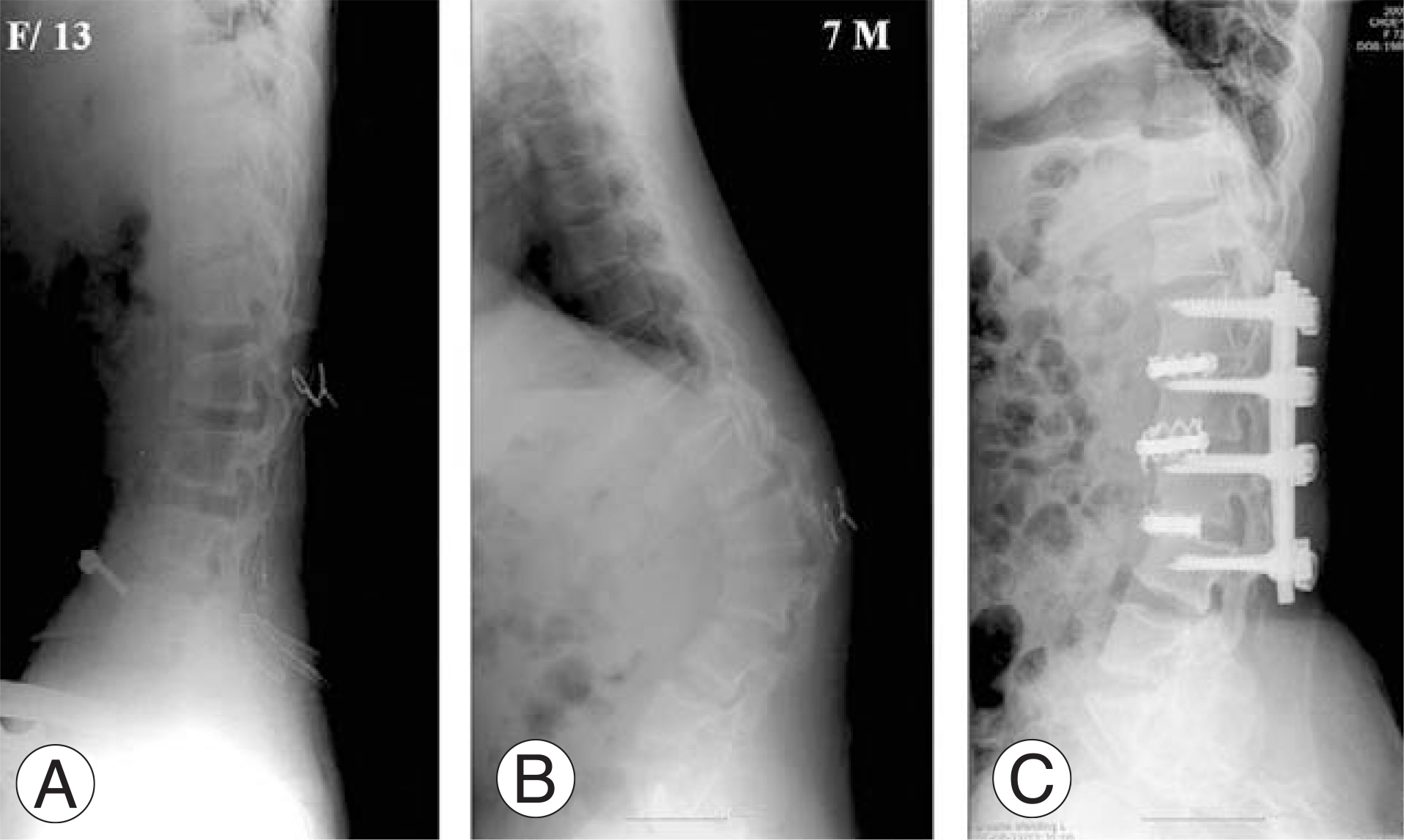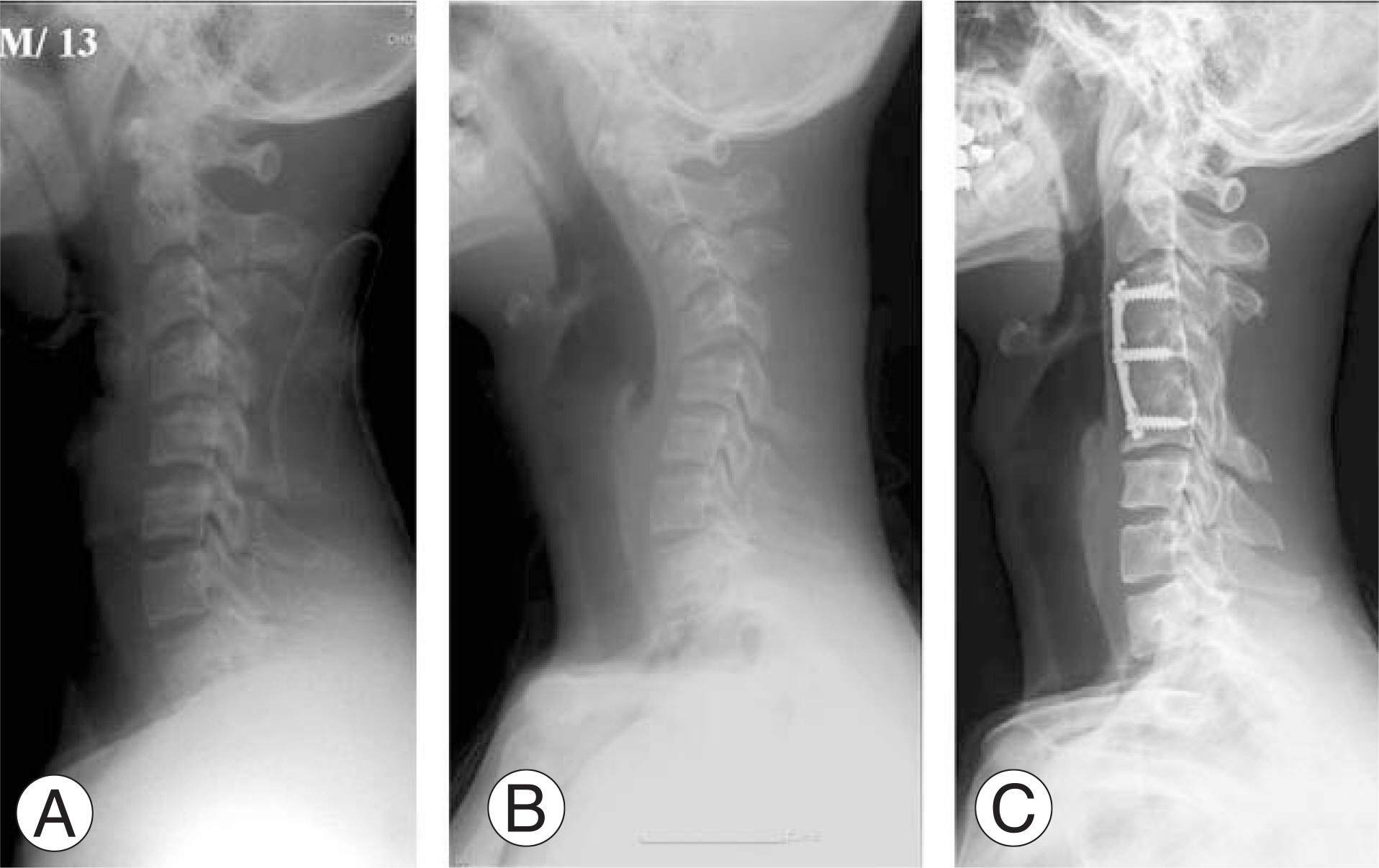J Korean Soc Spine Surg.
2007 Dec;14(4):270-277.
The Kyphotic Deformity After Multi-level Laminectomy
- Affiliations
-
- 1Department of Orthopaedic Surgery, Seoul National University College of medicine, Seoul, Korea. choonki@snu.ac.kr
- 2Department of Orthopaedic Surgery, Dongguk University International Hospital, Goyang, Korea.
Abstract
-
STUDY DESIGN: A Retrospective study
OBJECTIVES
To analyze the characteristics, risk factors, and outcomes of postlaminectomy kyphosis. SUMMARY OF LITERATURE REVIEW: Postlaminectomy kyphosis is uncommon and poorly understood, with controversy over the cause, risk factors, and treatment. MATERIAL AND METHODS: We included 17 patients (8 male, 9 female) who had undergone multilevel laminectomy between 1982 to 2006. Their mean age at the time of laminectomy was 16.3 years. The locations of laminectomy were: 4 cervical/cervicothoracic, 10 thoracic/thoracolumbar, and 3 lumbar. Possible factors for developing kyphotic deformities, such as an age at the time of laminectomy, sex, location, laminectomy extent, and radiation therapy were analyzed with the deformity angle and the time interval from the operation to the occurrence of deformity.
RESULTS
The mean time after surgery was 18.3 months, and the mean kyphotic angle was 58 degrees. Patients younger than 12 years or surgery involving more than 4 segments had a slightly shorter time interval, but not significantly. Location had no significant correlation with angle and time interval. Radiation therapy and sex were not significant factors. Most (15) patients received corrective surgery 49.9 months after laminectomy, which reduced deformities to an average of 34.5 degrees, whereas 2 patients had mild curvatures of 38 degrees (mean) One patient received a second operation due to pull-out of a rod, and one patient had a postoperative infection.
CONCLUSION
Postlaminectomy kyphosis attends to occur earlier in younger patients and patients with a large number of laminas resected, so careful observation should be done for early detection and management.
Keyword
Figure
Reference
-
1). Albert TJ, Vaccaro A. Postlaminectomy kyphosis, Spine. 1998; 23:2738–2745.2). Butler JC, Whitecloud TS. Postlaminectomy kyphosis. Orthop Clin Nor Am. 1992; 23:505–511.
Article3). Lonstein JE. Postlaminectomy Kyphosis. Clin Ortho Relat Res. 1977; 128:93–100.
Article4). Guigui P, Benoist M, Deburge A. Spinal deformity and instability after multilevel cervical laminectomy for spondylotic myelopathy. Spine. 1998; 23:440–447.
Article5). Katsumi Y, Honma T, Nakamura T. Analysis of cervical instability resulting from laminectomies for removal of spinal cord tumor. Spine. 1989; 14:1171–1176.
Article6). Zdeblick TA, Zou D, Warden KE, McCabe R, Kunz D, Vanderby R. Cervical stability after foraminotomy: a biomechanical in vitro analysis. J Bone Joint Surg Am. 1992; 74:2005–2008.
Article7). Breig A, el-Nadi AF. Biomechanics of the cervical spinal cord. Relief of contact pressure on and overstretching of the spinal cord. Acta Radiol Diagn. 1966; 4:602–624.8). Otsuka NY, Hey L, Hall JE. Postlaminectomy and postirradiation kyphosis in children and adolescents. Clin Orthop Relat Res. 1998; 354:189–194.
Article9). Kaptain GJ, Simons NE, Replogle RE, Pobereskin L. Incidence and outcome of kyphotic deformity following laminectomy for cervical spondylotic myelopathy. J Neurosurg. 2000; 93(2S):199–204.
Article10). Papagelopoulos PJ, Peterson HA, Ebersold MJ, Emmanuel PR, Choulhury SN, Quast LM. Spinal column deformity and instability after lumbar or thoracolumbar laminectomy for intraspinal tumors in children and young adults. Spine. 1997; 22:442–451.
Article11). Blam OG, Albert TJ, Vaccaro AR. Surgical reconstruction of postlaminectomy cervical kyphosis, Curr Opin Orthop. 2002; 13:208–213.12). Pal GP, Sherk HH. The vertical stability of the cervical spine. Spine. 1988; 13:447–449.
Article13). Bell DF, Walker JL, O'Conner G, Tibshirani R. Spinal deformity after multilevel cervical laminectomy in children. Spine. 1994; 19:40–411.14). Ain MC, Shirley ED, Pirouzmanesh BS, Hariri A, Car-son BS. Postlaminectomy kyphosis in skeletally immature achodroplast. Spine. 2006; 31:197–201.15). Fields MJ, Hoshijima K, Feng AH, Richardson WJ, Myers BS. A biomechanical, radiologic, and clinical comparison of outcome after multilevel cervical laminectomy or laminoplasty in the rabbit. Spine. 2000; 25:2925–2931.
Article16). Cattell HS, Clark GL Jr. Cervical kyphosis and instability following multiple laminectomies in children. J Bone Joint Surg Am. 1967; 49:713–720.
Article17). Schultz KD, Mclaughlin MR, Haid RW Jr, Comey CH, Rodts GE Jr, Alexander J. Single-stage anteriorposterior decompression and stabilization for complex cervical spine disorders. J Neurosurg. 2000; 93(2S):214–221.
Article18). Riew KD, Hilibrand AS, Palumbo MA, Bohlman HH. Anterior cervical corpectomy in patients previously man-aged with a laminectomy: short-term complications. J Bone Joint Surg Am. 1999; 81:950–957.19). Abumi K, Shono Y, Taneichi H, Ito M, Kaneda K. Correction of cervical kyphosis using pedicle screw fixation systems. Spine. 1999; 24:2389–96.
Article
- Full Text Links
- Actions
-
Cited
- CITED
-
- Close
- Share
- Similar articles
-
- Post-Laminectomy Swan Neck Deformity in Adults
- The Correlation between Insertion Depth of Prodisc-C Artificial Disc and Postoperative Kyphotic Deformity: Clinical Importance of Insertion Depth of Artificial Disc
- The Usefulness of Laminoplasty in Cervical Spinal Cord Tumor Surgery
- A new Technique of Posterior Closing Apical Correctional Osteotomy of the Thoracic of Lumbar Spine: A Report of Three Cases
- Multisegmental Osteotomy for Kyphotic Deformity in Ankylosing Spondylitis



